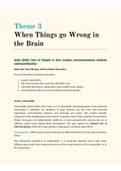Theme 3
When Things go Wrong in
the Brain
Stahl (2000): Part of Chapter 4: How synaptic neurotransmission mediates
emotional disorders
Molecular Neurobiology and Psychiatric Disorders
Four key elements of psychiatric disorders:
1. genetic vulnerability
2. life event stressors that come that individual's way
3. individual personality, coping skills, and available social support
4. environmental inuences on the individual and their genome
Genetic vulnerability
Vulnerability theoretically arises from a set of abnormally functioning genes. Some abnormal
functioning is inherited, but problems of gene function can also arise from personal
experiences, environmental stressors, and chemicals and toxins. The current scientic
consensus is that multiple genes must interact to produce most of the causation of a psychiatric
illness. Such genes act independently, additively, or even synergistically, and may also act at
different critical times during brain development. This goes against the classical view of
inherited disease, where for certain diseases, single genes contribute large effects.
Heterogeneity: different genes may be abnormal in different families with the same psychiatric
illness
The biochemical expression of vulnerability to a psychiatric disorder occurs when many
different genes make many important proteins in the wrong amounts, at the wrong places, or at
the wrong times.
,Life Events
Two-hit hypothesis: to develop a psychiatric disorder, one must sustain all the critical genetic
vulnerabilities (i.e., the rst hit), and also a second hit of sorts from the environment. Some
mental disorders may have a higher
chance of being expressed in
vulnerable persons. Thus, genetic
endowment gives a certain degree of
risk for a psychiatric disorder, and
certain disorders may have more of a
propensity to manifest than others.
Childhood Development, Personality, Coping Skills, and Social Support as Factors in
Psychiatric Illnesses
Environmental factors that inuence gene expression:
- Early life experiences → inuence what coping skills are learned
- Adult life experiences → are determined by stressors one encounters
- Personality traits → inuenced by environment & genome, which inuence coping skills
The more biologically determined disorders with the more vulnerable genomes require only
minor stressors for a person to develop that mental illness. A less vulnerable disorder might
require moderate stressors to become manifest. However, some stressors could be so severe that
even a normal robust genome might break down to cause a mental disorder.
, Neuronal Plasticity and Psychiatric Disorders
Neurodevelopmental Disorders
Neurons and synapses must develop properly and then be adequately maintained, or else a
disorder could result. First, the correct neurons must be selected in utero and they must migrate
to their predesignated locations. Abnormal neuronal migration possibly contributes to the
development of epilepsy, schizophrenia, and dyslexia.
Failure of neuronal migration could be caused by genes giving the wrong directions. Bad
instructions could be inherited, or acquired in utero (e.g., toxins can trigger the activation of a
"grim reaper" growth factor instead of a "bodyguard" growth factor, causing the wrong cells to
activate their apoptotic suicide system)
Other neurodevelopmental problems could result from abnormal synaptogenesis. If the neuron
receives the wrong semaphore signal (from neurotrophic semaphorin molecules), it may sail its
axonal growth tip into the wrong postsynaptic targets. Once innervation is complete,
information transfer in the brain continues to depend on synapse maintenance. If
synaptogenesis is interrupted early in development, the brain may not reach its full potential.





